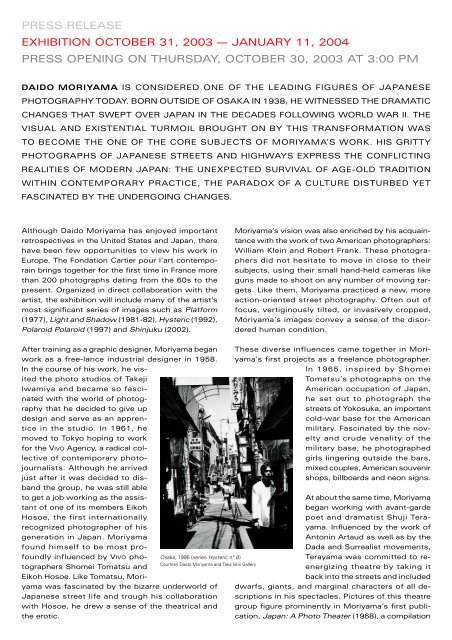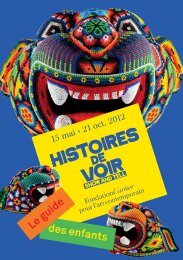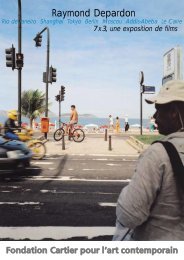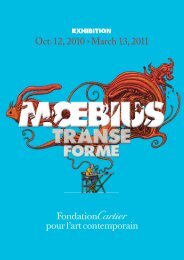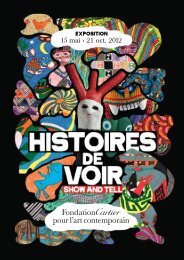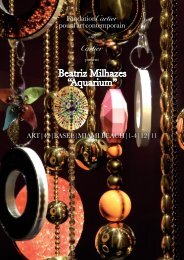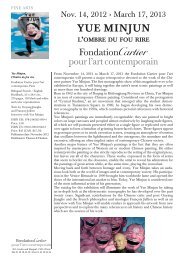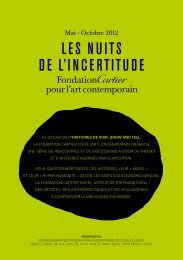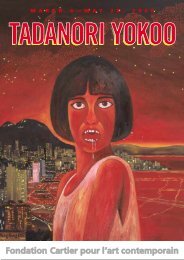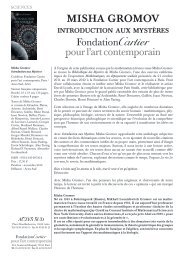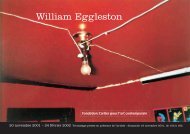DAIDO VERS PDF ANG - Fondation Cartier pour l'art contemporain ...
DAIDO VERS PDF ANG - Fondation Cartier pour l'art contemporain ...
DAIDO VERS PDF ANG - Fondation Cartier pour l'art contemporain ...
You also want an ePaper? Increase the reach of your titles
YUMPU automatically turns print PDFs into web optimized ePapers that Google loves.
PRESS RELEASE<br />
EXHIBITION OCTOBER 31, 2003 — JANUARY 11, 2004<br />
PRESS OPENING ON THURSDAY, OCTOBER 30, 2003 AT 3:00 PM<br />
<strong>DAIDO</strong> MORIYAMA IS CONSIDERED ONE OF THE LEADING FIGURES OF JAPANESE<br />
PHOTOGRAPHY TODAY. BORN OUTSIDE OF OSAKA IN 1938, HE WITNESSED THE DRAMATIC<br />
CH<strong>ANG</strong>ES THAT SWEPT OVER JAPAN IN THE DECADES FOLLOWING WORLD WAR II. THE<br />
VISUAL AND EXISTENTIAL TURMOIL BROUGHT ON BY THIS TRANSFORMATION WAS<br />
TO BECOME THE ONE OF THE CORE SUBJECTS OF MORIYAMA’S WORK. HIS GRITTY<br />
PHOTOGRAPHS OF JAPANESE STREETS AND HIGHWAYS EXPRESS THE CONFLICTING<br />
REALITIES OF MODERN JAPAN: THE UNEXPECTED SURVIVAL OF AGE-OLD TRADITION<br />
WITHIN CONTEMPORARY PRACTICE, THE PARADOX OF A CULTURE DISTURBED YET<br />
FASCINATED BY THE UNDERGOING CH<strong>ANG</strong>ES.<br />
Although Daido Moriyama has enjoyed important<br />
retrospectives in the United States and Japan, there<br />
have been few opportunities to view his work in<br />
Europe. The <strong>Fondation</strong> <strong>Cartier</strong> <strong>pour</strong> l’art <strong>contemporain</strong><br />
brings together for the first time in France more<br />
than 200 photographs dating from the 60s to the<br />
present. Organized in direct collaboration with the<br />
artist, the exhibition will include many of the artist’s<br />
most significant series of images such as Platform<br />
(1977), Light and Shadow (1981-82), Hysteric (1992),<br />
Polaroid Polaroid (1997) and Shinjuku (2002).<br />
After training as a graphic designer, Moriyama began<br />
work as a free-lance industrial designer in 1958.<br />
In the course of his work, he visited<br />
the photo studios of Takeji<br />
Iwamiya and became so fascinated<br />
with the world of photography<br />
that he decided to give up<br />
design and serve as an apprentice<br />
in the studio. In 1961, he<br />
moved to Tokyo hoping to work<br />
for the VIVO Agency, a radical collective<br />
of contemporary photojournalists.<br />
Although he arrived<br />
just after it was decided to disband<br />
the group, he was still able<br />
to get a job working as the assistant<br />
of one of its members Eikoh<br />
Hosoe, the first internationally<br />
recognized photographer of his<br />
generation in Japan. Moriyama<br />
found himself to be most pro-<br />
foundly influenced by VIVO photographers<br />
Shomei Tomatsu and<br />
Eikoh Hosoe. Like Tomatsu, Moriyama<br />
was fascinated by the bizarre underworld of<br />
Japanese street life and trough his collaboration<br />
with Hosoe, he drew a sense of the theatrical and<br />
the erotic.<br />
Osaka, 1996 (series Hysteric n° 8)<br />
Courtesy Daido Moriyama and Taka Ishii Gallery<br />
Moriyama’s vision was also enriched by his acquaintance<br />
with the work of two American photographers:<br />
William Klein and Robert Frank. These photographers<br />
did not hesitate to move in close to their<br />
subjects, using their small hand-held cameras like<br />
guns made to shoot on any number of moving targets.<br />
Like them, Moriyama practiced a new, more<br />
action-oriented street photography. Often out of<br />
focus, vertiginously tilted, or invasively cropped,<br />
Moriyama’s images convey a sense of the disordered<br />
human condition.<br />
These diverse influences came together in Moriyama’s<br />
first projects as a freelance photographer.<br />
In 1965, inspired by Shomei<br />
Tomatsu’s photographs on the<br />
American occupation of Japan,<br />
he set out to photograph the<br />
streets of Yokosuka, an important<br />
cold-war base for the American<br />
military. Fascinated by the novelty<br />
and crude venality of the<br />
military base, he photographed<br />
girls lingering outside the bars,<br />
mixed couples, American souvenir<br />
shops, billboards and neon signs.<br />
At about the same time, Moriyama<br />
began working with avant-garde<br />
poet and dramatist Shuji Terayama.<br />
Influenced by the work of<br />
Antonin Artaud as well as by the<br />
Dada and Surrealist movements,<br />
Terayama was committed to reenergizing<br />
theatre by taking it<br />
back into the streets and included<br />
dwarfs, giants, and marginal characters of all descriptions<br />
in his spectacles. Pictures of this theatre<br />
group figure prominently in Moriyama’s first publication,<br />
Japan: A Photo Theater (1968), a compilation


